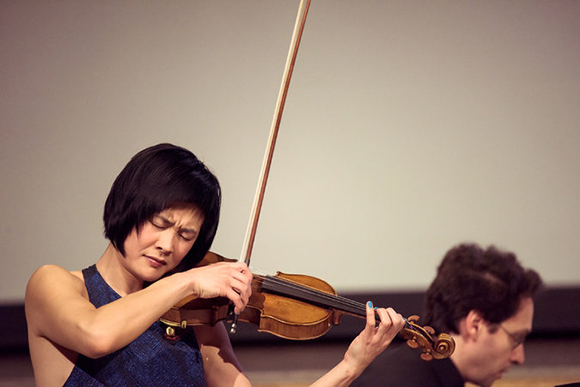The New York Times
By Anthony Tommasini
March 22, 2016
original
link
Review: Anthony Cheung’s ‘Elective Memory,’ a Response to Beethoven

Jennifer Koh and the pianist Shai Wosner pair Beethoven pieces with new works at the 92nd Street Y.
Credit Loren Wohl for The New York Times
When the violinist Jennifer Koh asked Anthony Cheung to write a piece for her, responding to Beethoven, he happened to be already working on “Lyra,” a commission from the New York Philharmonic partly inspired by that composer’s Fourth Piano Concerto.
But he took on Ms. Koh’s assignment, too, and on Monday she and the pianist Shai Wosner gave the New York premiere of Mr. Cheung’s “Elective Memory” in Buttenwieser Hall, an intimate space at the 92nd Street Y, ideal for chamber music. The concert was the third in Bridge to Beethoven, these players’ series pairing Beethoven’s violin sonatas with new works exploring his influence.
The program opened with Beethoven’s Violin Sonata No. 3 in E flat (Op. 12, No. 3) and ended with Beethoven’s last work in the genre, the Sonata No. 10 in G (Op. 96). In between, Ms. Koh and Mr. Wosner played “Elective Memory,” a duo in three movements, lasting about 18 minutes, written as a response to that final Beethoven violin sonata.
Hints of Beethoven’s Sonata in G permeate Mr. Cheung’s piece. The first movement, “Aubade, for a Golden Age,” begins with a hazy recollection of Beethoven’s strange opening theme, which is really just a motif, a “birdcall trill,” as Mr. Cheung aptly describes it in a program note. That element and others are put through what sounds like a process of cosmic rumination. Faintly wailing violin lines interact with oscillating intervals and murky chords in the piano.
The musical language combines atonal and tonal aspects into lush, mystical sonorities. At one point, the music turns frantic, a shift subtly signaled during the quizzical opening. “Broken Scherzo: Tripping Up, Falling Down,” the second movement, is even more jumpy and fragmented, with skittish bursts that suggest both jazzy improvisation and ethereal Messiaen. The third movement, “Nocturne, Half-Remembered,” returns to the elusive world of the first section, but with more pronounced lyricism.
Ms. Koh and Mr. Wosner played the piece beautifully, though it might have been more helpful to hear it after the sonata that inspired it, which was given an eloquent performance here. The scintillating account of the feisty Beethoven sonata that opened the program was also especially enjoyable.
Copyright © The New York Times
© Jennifer Koh, All Rights Reserved. Photography by Juergen Frank. Site by ycArt design studio